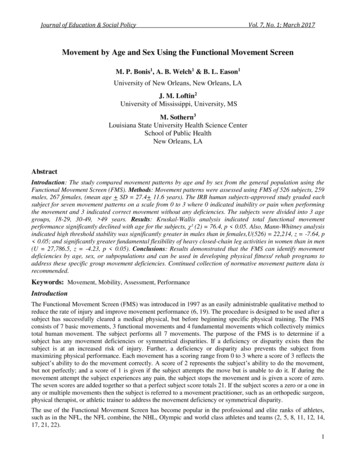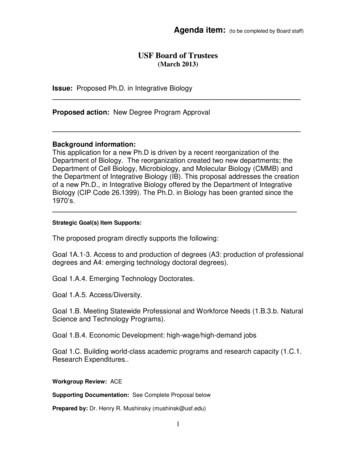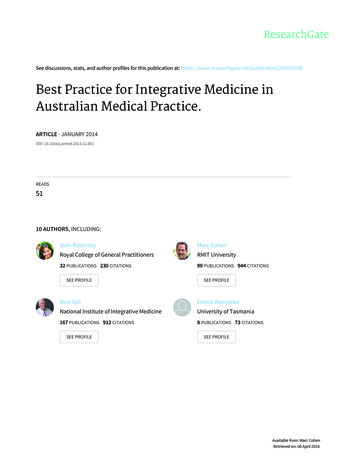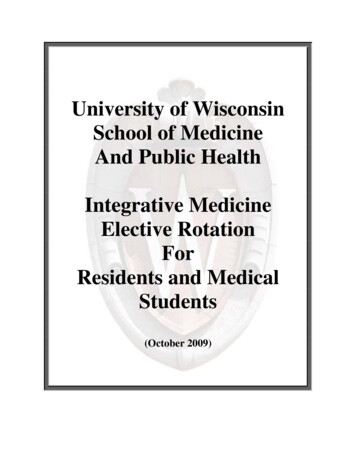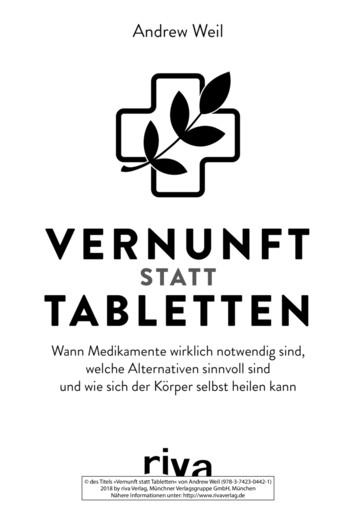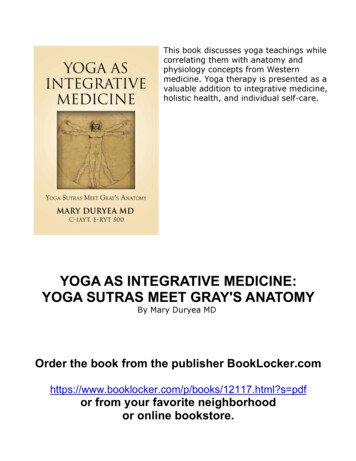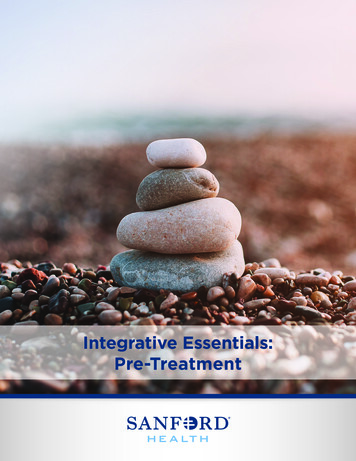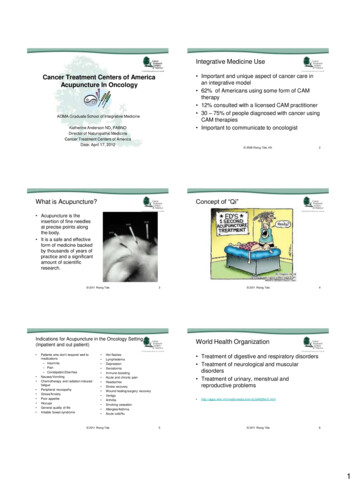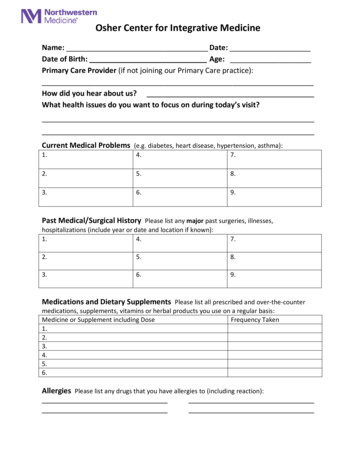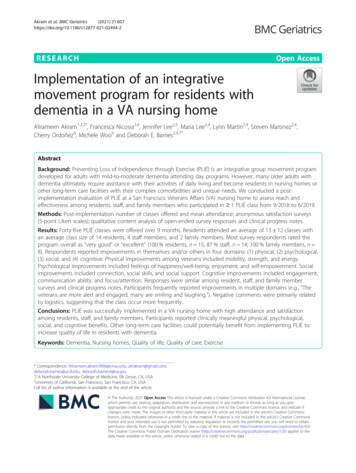
Transcription
Akram et al. BMC Geriatrics(2021) SEARCHOpen AccessImplementation of an integrativemovement program for residents withdementia in a VA nursing homeAlirameen Akram1,2,3*, Francesca Nicosia2,4, Jennifer Lee2,5, Maria Lee2,4, Lynn Martin2,4, Steven Martinez2,4,Cherry Ordoñez6, Michele Woo6 and Deborah E. Barnes2,4,7*AbstractBackground: Preventing Loss of Independence through Exercise (PLIÉ) is an integrative group movement programdeveloped for adults with mild-to-moderate dementia attending day programs. However, many older adults withdementia ultimately require assistance with their activities of daily living and become residents in nursing homes orother long-term care facilities with their complex comorbidities and unique needs. We conducted a postimplementation evaluation of PLIÉ at a San Francisco Veterans Affairs (VA) nursing home to assess reach andeffectiveness among residents, staff, and family members who participated in 1 PLIÉ class from 9/2018 to 6/2019.Methods: Post-implementation number of classes offered and mean attendance; anonymous satisfaction surveys(5-point Likert scales); qualitative content analysis of open-ended survey responses and clinical progress notes.Results: Forty-five PLIÉ classes were offered over 9 months. Residents attended an average of 13 12 classes withan average class size of 14 residents, 4 staff members, and 2 family members. Most survey respondents rated theprogram overall as “very good” or “excellent” (100 % residents, n 15; 87 % staff, n 14; 100 % family members, n 8). Respondents reported improvements in themselves and/or others in four domains: (1) physical, (2) psychological,(3) social, and (4) cognitive. Physical improvements among veterans included mobility, strength, and energy.Psychological improvements included feelings of happiness/well-being, enjoyment, and self-empowerment. Socialimprovements included connection, social skills, and social support. Cognitive improvements included engagement,communication ability, and focus/attention. Responses were similar among resident, staff, and family membersurveys and clinical progress notes. Participants frequently reported improvements in multiple domains (e.g., “Theveterans are more alert and engaged, many are smiling and laughing.”). Negative comments were primarily relatedto logistics, suggesting that the class occur more frequently.Conclusions: PLIÉ was successfully implemented in a VA nursing home with high attendance and satisfactionamong residents, staff, and family members. Participants reported clinically meaningful physical, psychological,social, and cognitive benefits. Other long-term care facilities could potentially benefit from implementing PLIÉ toincrease quality of life in residents with dementia.Keywords: Dementia, Nursing homes, Quality of life, Quality of care, Exercise* Correspondence: Alirameen.akram3966@cnsu.edu; alirakram@gmail.com;deborah.barnes@ucsf.edu; deborah.barnes4@va.gov1CA Northstate University College of Medicine, Elk Grove, CA, USA2University of California, San Francisco, San Francisco, CA, USAFull list of author information is available at the end of the article The Author(s). 2021 Open Access This article is licensed under a Creative Commons Attribution 4.0 International License,which permits use, sharing, adaptation, distribution and reproduction in any medium or format, as long as you giveappropriate credit to the original author(s) and the source, provide a link to the Creative Commons licence, and indicate ifchanges were made. The images or other third party material in this article are included in the article's Creative Commonslicence, unless indicated otherwise in a credit line to the material. If material is not included in the article's Creative Commonslicence and your intended use is not permitted by statutory regulation or exceeds the permitted use, you will need to obtainpermission directly from the copyright holder. To view a copy of this licence, visit http://creativecommons.org/licenses/by/4.0/.The Creative Commons Public Domain Dedication waiver ) applies to thedata made available in this article, unless otherwise stated in a credit line to the data.
Akram et al. BMC Geriatrics(2021) 21:607BackgroundBy 2050, the prevalence of Alzheimer’s disease and otherdementias is projected to increase from 6 to 16 millionin the United States, with one million new cases per year[1]. People with dementia (PWD) experience a progressive decline in cognitive function and increasing loss ofindependence that often negatively impacts their overallwell-being, such as their mood and self-image, whichcan further reduce their quality of life.Many PWD ultimately require assistance with theirbasic daily activities and become residents in nursinghomes. Overall, 48 % of nursing home residents acrossthe United States have Alzheimer’s or other dementias,and 61 % of PWD in nursing homes have moderate orsevere cognitive impairment [2]. Veterans with dementiaare especially complex patients with unique needs, sincethey frequently have mental health comorbidities suchas post-traumatic stress disorder, substance use disorders, physical illnesses or injuries such as traumaticbrain injuries, and/or may be homeless [3]. Disruptiveand challenging behavioral symptoms often prevent theplacement of veterans with dementia in communitylong-term care settings because they may pose health orsafety risks to themselves or others, and those with themost severe symptoms are often cared for by nursinghomes run by the Department of Veterans Affairs (VA),which are called Community Living Centers (CLCs).The current mainstay pharmacological treatments forPWD (acetylcholinesterase inhibitors and memantine)are associated with small symptomatic relief for somepatients, but ultimately lack neuroprotective effects, donot alter the disease course, and do not improve qualityof life [4]. Furthermore, the substantial adverse effects ofnausea, vomiting, diarrhea, and fatigue lead manypatients to discontinue these medications [5]. In contrast, there is a growing body of evidence that nonpharmacological interventions such as physical activity,cognitive/social stimulation and music therapy can improve a wide array of health outcomes while being muchsafer and sustainable [6–9]. Yet, few evidence-basednon-pharmacological programs have been widely implemented and evaluated, particularly in the VA nursinghome setting.Preventing Loss of Independence through Exercise(PLIÉ) is an integrative group movement programthat was originally developed for people with mildto-moderate dementia attending adult day programs[10, 11]. PLIÉ is grounded in neuroscience and targets abilities that are relatively well-maintained inPWD including the ability to learn new movementsequences to support daily function through repetition and procedural memory; the ability to notice inthe-moment bodily sensations; and the ability to experience joy and connect in meaningful ways withPage 2 of 11others. PLIÉ is also targets five key domains associated with better quality of life in PWD: physicalfunction, cognitive function, well-being, social connection, and self-esteem [12–17].The Core Elements of the PLIÉ program are shown inFig. 1. Each 45- to 60-minute class begins with participants seated in a circle and the instructor welcomingeveryone to create a warm, accepting environment. Theinitial movement sequences involve tapping, massagingand naming body parts to bring participants into awareness of their bodies in the present moment. This isfollowed by deep breathing with arm movements andvocalization to promote full body breathing and a mindful rest. The instructor then leads the class through aseries of upper and lower body movements sequencesthat are tailored to the needs and ability levels of thegroup. Step-by-step instruction and an errorless learningprocess are used to enable all participants to experiencefeelings of success. Many movements are interactive toencourage social engagement. Personally meaningfulmusic is incorporated to enhance positive emotions.Each class ends with a repetition of the full-bodytapping, massaging, and breathing, and participants areinvited to share what brings them feelings of joy, happiness or appreciation.The original PLIÉ program and an adapted version forPWD and caregivers called Paired PLIÉ have shown clinically meaningful benefits for older adults with dementiaand their care partners in the domains of physical, cognitive, and social and emotional functioning [10, 11, 18].The goal of this study was to adapt PLIÉ for implementation at the San Francisco (SF) VA CLC and to evaluate theprogram’s impact on residents, staff, and family members.MethodsAdaptation of PLIÉ for VA CLCIn 2017, we received a VA Innovators Award to explorestrategies for scaling PLIÉ to reach more veterans. Wefirst conducted semi-structured interviews with keystakeholders, including VA national and local leaders,local clinical providers, community partners, veteranswith dementia, and caregivers to learn about the statusof VA care for veterans with dementia and unmet needsfor CLC residents with dementia. We then identifiedtwo CLC clinical champions interested in becomingtrained PLIÉ instructors–a Psychiatric Mental HealthClinical Nurse Specialist (LM) and a Geriatric NursePractitioner specializing in Restorative Care (ML)–andsolicited their input on program adaptations to addresslocal needs. Key adaptations (Fig. 1) included: (1) no restrictions on class size (originally maximum of 10 participants with 2 instructors); (2) allowing participants inwheelchairs (originally excluded) and shifting movementfocus from sit-to-stand transition to range-of-motion
Akram et al. BMC Geriatrics(2021) 21:607Page 3 of 11Fig. 1 Preventing Loss of Independence through Exercise (PLIÉ) Core Elements and Adaptationsgiven greater levels of functional impairment; (3) allowing participants with comorbid mental and physicalhealth issues (originally excluded); and (4) allowing nonresident participants including CLC staff, family orfriends, volunteers, and paid caregivers (originally excluded). In addition, we assisted with creating a PLIÉclinical progress note template so that champions couldreceive work credit for leading classes and tracking residents’ participation and progress over time.We then provided clinical champions with 14 weeks ofexperiential training from February 2018 to June 2018facilitated by the PLIÉ Senior Instructor (JL) whoassisted with study design and implementation. This included: (1) providing a detailed PLIÉ Training Manual;(2) conducting a brief ‘goals assessment’ and medicalrecord review for each potential participant with clinicalchampions to help tailor the program to best meet participants’ goals and needs; (3) assisting with setting upthe room and selecting personally meaningful music forclasses; (4) providing and training in use of textured rubber balls for sensory stimulation; (5) providing weekly‘teaching plans’ describing key program elements thatwould be emphasized; (6) delivering the program 2 days/week for 12 weeks with clinical champions participatingas active assistants; and (7) debriefing with clinicalchampions after each class to assess what went well,what should be changed, and answer any questions.Feedback from debriefing sessions was continuously incorporated into the PLIÉ program in order to adapt toparticipants’ evolving needs. After the 14-week trainingperiod, the clinical champions led classes on their ownfor another 12 weeks with the Senior Instructor attending once per week for 4–6 weeks to provide feedbackand support. After the clinical champions taught classeson their own, the Senior Instructor returned weekly for4 weeks and then monthly for 3 months to provide feedback and support.Post-implementation evaluationIn June 2019, approximately one year after the initialtraining was completed, we conducted an evaluation ofPLIÉ implementation guided by the first two components of the Reach Effectiveness Adoption Implementation Maintenance (RE-AIM) framework [19, 20]. Weassessed reach by reviewing class attendance logs to determine the number of classes offered, number of participants per class, and number of classes attended by eachresident. We assessed effectiveness by administering anonymous surveys to those who attended one or moreclasses and analyzed PLIÉ clinical progress notes of resident participants.Three related versions of the survey were created for(1) residents, (2) CLC staff and other non-resident participants such as volunteers, paid caregivers, andtrainees, and (3) family members/friends. The surveyswere administered to residents by the PLIÉ clinicalchampions who determined cognitive capacity of theresidents based on clinical judgement and obtained verbal consent/assent for their participation. The first sixquestions asked participants to rate specific experiencesduring PLIÉ classes (e.g., I feel energized; I feel relaxed)using a 4-point Likert scale (never/rarely, sometimes,often, mostly/always). Overall satisfaction with PLIÉ wasrated on a 5-point Likert scale (poor, fair, good, verygood, excellent). All surveys ended with five open-endedquestions about changes observed in themselves andother class participants as a result of participating in
Akram et al. BMC Geriatrics(2021) 21:607PLIÉ classes, what they liked most and least, and othercomments.AnalysisWe analyzed qualitative data using a hybrid deductiveand inductive approach to content analysis [21]. First,we applied codes developed in a previous qualitativeevaluation of Paired PLIÉ. This included the followingdomains: physical (e.g., mobility); psychological (e.g.,well-being); social (e.g., connectedness); and cognitive(e.g., communication). One coder (AA) applied initialcodes to open-ended survey responses. Second, duringthe coding process, AA identified new concepts fromparticipants’ own words and developed preliminary inductive codes. The larger study team (AA, SM, MW,CO, FN, and DB) regularly reviewed findings and refinednew codes through team-based discussions and consensus process. AA also reviewed PLIÉ clinical progressnotes to identify descriptions of changes in key domainsthat were specifically attributed to participation in PLIÉclasses [22].ResultsReachClinical champions offered 45 PLIÉ classes during the 9month evaluation period (September 2018 to June 2019).A total number of 50 residents participated in PLIÉ atleast once. On average, residents attended 13 12classes. The maximum number of classes attended byone resident was 40. In addition to the two clinicalchampions, PLIÉ classes included an average of 20 participants: 14 residents; 4 staff members, caregivers, volunteers, or trainees (e.g. nursing students, occupationalPage 4 of 11therapy students); and 2 family members or friends ofresidents. At baseline, residents had a range of cognitiveand functional abilities from ambulatory with supervision to non-ambulatory, able to communicate clearly toaphasic, and participating in multiple groups throughoutthe day and week versus disruptive in other group settings. The outpatient PLIÉ model involved mild-tomoderate cognitive impairment in which the older adultshad good physical function (e.g. could stand up and sitdown multiple times) whereas our residents were mostlywheelchair bound and needed assistance with transfersto the chair.EffectivenessSixteen residents, 14 staff, and 8 family members wereinvited to take the survey, and all but one residentagreed to participate. The vast majority of residents,staff, and family members responded positively to all ofthe survey items about the PLIÉ classes (Table 1). Forexample, 100 % of residents, 87 % of staff, and 100 % offamily rated the program overall as “very good” or “excellent.” In addition, 100 % of the residents respondedpositively to statements such as “I feel that I belong,”93 % of staff responded positively to statements such as“I learn new skills for interacting with residents,” and100 % of family members responded positively to statements such as “I feel closer to my family member.”Benefits for residentsResidents, family, and staff also reported benefits in residents during the PLIÉ classes across the followingdomains: (1) physical, (2) psychological, (3) social, and(4) cognitive (Table 2).Table 1 Satisfaction ratings for residents, staff, and family membersPercent positive rating(mean SD)When participating in the PLIÉ classes, to what extent do you experience the following?ResidentsN 15Staff N 14Family N 81. I feel that I belong / I learn new skills for interacting with residents / my family member100 %(3.9 0.3)93 %(3.4 0.6)88 %(3.1 0.6)2. I feel that I am accepted / I feel closer to residents / my family member100 %(4.0 0.0)93 %(3.7 0.6)100 %(3.9 0.4)3. I feel that my problems are not unique / I feel that I am part of a team / I feel that the staffhere really care about my family member100 %(4.0 0.0)87 %(3.4 1.1)75 %(4.0 0.0)4. I feel energized87 %(3.7 0.7)87 %(3.6 0.8)88 %(3.5 0.9)5. I feel relaxed93 %(3.9 0.5)93 %(3.7 0.6)100 %(3.6 0.7)6. I enjoy being together with a group of people like me / I enjoy my work / I am happy withthe care my family member receives here100 %(3.9 0.3)87 %(3.5 0.9)100 %(4.0 0.0)7. How would you rate your overall satisfaction with the PLIÉ program?100 %(4.6 0.9)87 %(4.4 0.9)100 %(4.9 0.4)Questions 1–6 rated on 4-point Likert scale (never/rarely, sometimes, often, mostly/always) with responses of often or mostly/always considered positive. Question7 rated on 5-point Likert scale (poor, fair, good, very good, excellent) with responses of very good/excellent considered positive
Akram et al. BMC Geriatrics(2021) 21:607Page 5 of 11Table 2 Changes observed in self as a result of participating in PLIÉ classesMain Code(s)Sub-Code(s)Resident QuoteStaff QuotePsychologicalWell-being“Happier.”“It makes me feel good knowing “It makes me smile!”the residents are able to partake.”Self-Empowerment“I’m not only one who is disabled, “I developed a lot ofsome more/some less; I seeindependence about myself.”others more disabled then I tryharder.”“I’m more willing to exercise.”Connection /Support“I feel safe. I feel welcome.”“I get to know the other veterans.”Social Skills“I have more empathy for others.” “Learned how to interact withveteran, learned vets’ favorites.”“I have new skills to interact with myhusband as well as other veterans.”Energy / Mobility /General“Improve my physical well-being.” “Body flexibility.”SocialPhysicalPsychological Relax CognitiveWell-Being Engagement“I’m new to them. I like thefeeling of calm. And I love seeingveterans so happy and engaged.”Psychological Connection EnjoySocial“Have not attended PLIÉ for along time but observed vets areinteractive and enjoying thisactivity.”Well-being ConnectionPhysical SocialEnergy ConnectionPsychological SelfSocial Empowerment CognitiveSocial Skills Communication/Language(1) Physical. Residents reported a variety of personalphysical benefits of participating in PLIÉ, including increased energy/alertness, flexibility, mobility, balance,strength, and general physical well-being. For example, aresident reported “[PLIÉ] improves my physical wellbeing” and a resident noted that “[PLIÉ] gets me out ofbed more.” Sometimes, these positive physical changeswere coupled with positive social changes as indicatedby a family member who reported, “he is more social,and he moves better.”(2) Psychological. The most common psychologicalchange among residents was improved feelings ofwell-being and self-empowerment. We defined selfempowerment to be signs of positive thinking, increased motivation towards their goals, and greaterself-esteem in taking charge of their life. Examplesinclude, “I’m more willing to exercise,” and “I seepeople making a greater effort, feeling inspired, feeling connected, feeling hopeful, feeling like [they] belong.” Many residents reported feeling “Happier.”One resident reported feeling motivated by participating in PLIÉ: “I’m not the only one who is disabled. When I see other [residents] who are more orless disabled, I try harder.” Family and staff noticedFamily Quote“I noticed that patients arealways happy, singing andinteracting with each other feelsgood.”“More energy, sense of connection toother vets, staff and community.”“I have a new appreciation for life. It’seasier to communicate with myhusband. I learn how tocommunicate with him.”increased positive emotions and self-empowermentin residents, with some residents also noticing theseimprovements in other veterans (Table 3). Oneresident reported, “The others are happier too, especially Mr. X who sings or tries to talk with a smileon his face.”(3) Social. Most residents reported increased feelingsof connection, social skills, and social support. As oneresident mentioned, “The entire group is very friendlyand makes me feel safe to express myself. I love the facilitators.” Other comments included, “I have more empathy for others,” and “I feel safe. I feel welcome.” Onestaff member commented, “I see people making a greatereffort, feeling inspired, feeling connected, feeling hopeful, feeling like they belong.”(4) Cognitive. Several family members observedincreased cognitive engagement in their loved ones (e.g.,“They are more alert and engaged”). In addition,some residents noticed increased communication/language skills in other veterans. For example, one resident reported “Some [residents] made physical gains.Some speak better,” and another said, “Peer who wasnot able to speak before is trying to talk more andsometimes does”).
Akram et al. BMC Geriatrics(2021) 21:607Page 6 of 11Table 3 Changes observed in others as a result of participating in PLIÉ classesMain Code(s)Sub-Code(s)Resident QuotePsychologicalWell-Being“The others are happier too. Especially Mr. X “I think there’s a lot of improvementwho sings or tries to talk with a smile onabout themselves as well.”his face.”Staff QuoteEnjoy“Everyone seemed to enjoy themselves”CognitiveEngagement“Vets are eager to attend this activity.”“More engaged.”SocialMobility/Strength“People are getting stronger.”General“Yes- it helps everyone do a little morephysically.”Social Skills“They are friendly and behave inclasses.”Connection“The dynamic with everybody doingis fantastic.”Social Support“They get more involved withencouragement from volunteers orfacilitators.”Psychological Well-Being CognitiveEngagement“Helps everyone with their mind and spirit.[Other veteran who is usually low-energy]actually participated and was veryanimated.”“Veterans look very happyand enthusiastic toparticipate.”“The veterans are morealert and engaged, manyare smiling and laughing.”Focus/Attention Engagement Well-BeingGeneral Communication/Language“Some made physical gains. Some speakbetter.”Psychological SelfSocialEmpowerment ConnectionCognitive PhysicalSocial Physical“More participation.”“The participants are more alert.”Focus/ AttentionPhysicalFamily Quote“The veterans are morealert and engaged, manyare smiling and laughing.”“I see people making a greater effort,feeling inspired, feeling connected,feeling hopeful, feeling like youbelong.”“Many of the veterans aremore engaged and activeduring and after the class.”Engagement Energy/ActivityLevelCommunication/Language General“Mr. Y can kick the ball and talk!”Social Skills Mobility/Strength“Increased strength, movement,social, and empathy.”Psychological Enjoy Physical General SocialConnectionConfirmation in clinical progress notesPLIÉ clinical progress notes written by clinical champions after each class echoed changes in physical, psychological, social, and cognitive domains reported byresidents, staff, and family members. A total of 419 progress notes were reviewed for 27 residents. Positivechanges were noted for 15 residents (56 %). For example,one note described physical improvements: “He demonstrates improved balance. He is now able to transfer withminimal assistance from wheelchair to regular chair.”“He’s more social, and hemoves better.”“Enjoyment of movement,play, and interaction.”This same note continued with “He often commentshow proud and comfortable he is to be in a regularchair,” indicating related psychological benefits such asself-empowerment. Social and cognitive benefits werereported in another resident, whose progress note stated,“She is more interactive and engaged when she participates in the structured interventions of PLIÉ than whenshe is out in the general milieu.” Cognitive changes related to communication skills were reported in anotherresident: “Each week, he practices telling the group what
Akram et al. BMC Geriatrics(2021) 21:607Page 7 of 11he is grateful for. His ability to make himself understoodverbally is increasing with time and practice.” Sometimesevaluations touched on multiple domains: “Mr. G. wasfully engaged, enthusiastic, and fully participatorythroughout group. This is remarkable for this veteranwith advanced dementia. He smiles from ear to ear anddemonstrates that he is learning how to use his righthand to work with his paralyzed left hand through thecoaching he receives from the clinical champions. Inaddition, his [caregiver] is learning and modeling how toengage him in ways that are pleasant, meaningful and interesting for him.” Although most progress notes described positive changes, 6 resident notes (22 %)described changes such as falling asleep in class or beingasking to leave the session for behavioral disruptions.meaningful improvements to their psychological wellbeing, ability to cope, and caregiving skills resulting fromparticipation in PLIÉ. One family member reported, “Ihave a new appreciation for life. It’s easier to communicate with my husband. I learned how to communicatewith him.” A similar sentiment was shared by a staffmember who stated, “I have more empathy. I see moreof people’s strengths and resilience and perseverance.”Staff members reported feelings of relaxation and enjoyment (e.g. “I like the feeling of calm. And I love seeingveterans so happy and engaged”). A staff member noticed her greater social connectedness through feeling,“More energy, sense of connection to other vets, staffand community” as a result of participating in PLIÉ.Overall satisfactionPositive ripple effect of PLIÉ on family and staffIn addition to changes observed in residents, severalfamily members and staff reported experiencingWhen asked what they liked most, majority of participants from all three groups described liking “all” or“everything” about the PLIÉ classes (Table 4). ManyTable 4 What people liked most about PLIÉMain dent Quote“It made me a betterperson.”Staff QuoteFamily Quote“Fun.”“I think most really enjoy it!”“Makes patient to feel at home andhappy.”“The participants light up when theyget a turn.”CognitiveEngagementSocialSocial Support“Gave me the opportunityto try to communicate thefrustrations I feel from livinghere.”Social Support“Encouraging others.”Connection“Interacting with others.”“Feeling part of a group.”General“The ability to physicallystretch.”“Exercises, stretching, breathe.”PhysicalGeneral“A lot of merit to it and I tryto keep up with it.”Staff/Volunteers“The volunteer Ms. M”“Loves all of it - somethings that arerepeated; other new things.”“I love the music.”Equipment/Technique“Throwing the ball.”“Passing around the ball, and upperextremity exercises.”Social Support SelfEmpowerment“When the teacher goesaround and prompts you toshare how you feel at theend of group.”“Everyone makes an effort and isencouraging.”Psychological SelfPhysicalEmpowerment GeneralPsychological Enjoy WellLogistics/being Music Others EngagementCognitive“Everything! I like everything.”“The instructors. They make it fun.”MusicSocial Psychological“Everyone is encouraged to participate tobest ability.”“Vets participate even those who sleepat the beginning of the session andbegin to actively participate at thebeach ball ing vets with physical andcognitive challenges feel they belongand helping each other.”“Positive energy and exercise, verybeneficial to our residents.”“I enjoy the music and the sing along Isee other family members smilingbecause they see their family membershappy and engaged.”
Akram et al. BMC Geriatrics(2021) 21:607participants specifically mentioned liking the social component of the PLIÉ classes. For example, one residentstated, “interactions with others” was his favorite. Othersmentioned liking the feelings of well-being derived fromthe PLIÉ classes, increased self-empowerment, enjoyingthemselves and seeing others enjoy themselves. Forexample, another resident stated, “It made me a betterperson.” Some liked the physical improvements (e.g. “theability to physically stretch”) and increased energy/activity levels, while some respondents emphasized their joyin seeing participants “light up” and be more cognitivelyengaged. Some said they loved the music the most. Afew described liking two aspects of the program equally(e.g. “I enjoy the music and seeing residents smiling withtheir family members”).When asked what they liked least about PLIÉ, severalrespondents commented on time/frequency, wishing theclass was longer in duration, offered more often, or mentioning they disliked when class was canceled. Some staffmembers mentioned logistics regarding music, such assuggestions to involve more music or trying new musicstyles. One resident and one staff mentioned the equipment (e.g. “small ball”) as what they liked the least, andone staff member mentioned not having enough staff/volunteers to maximize participation.DiscussionOur post-implementation evaluation of PLIÉ-CLC at SFVA showed that the program reached a large number ofveterans, became a popular activit
trast, there is a growing body of evidence that non-pharmacological interventions such as physical activity, cognitive/social stimulation and music therapy can im-prove a wide array of health outcomes while being much safer and sustainable [6-9]. Yet, few evidence-based non-pharmacological programs have been widely imple-

